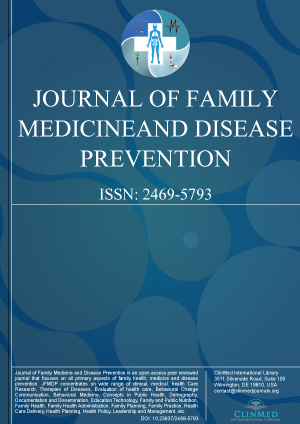Open Access DOI:10.23937/2469-5793/1510037
Examining Characteristics of Hospitalizations in Heart Failure Patients: Results from the 2009 All-payer Data
Lufei Young, Carol Gilbert, Jungyoon Kim, Yaewon Seo, Fernando A Wilson and Li-Wu Chen
Article Type: Original Article | First Published: June 28, 2016
Heart failure (HF) is one of the most common chronic and disabling illnesses, resulting in high morbidity and mortality. Readmission rate, one key indicator of healthcare quality and healthcare utilization, is prevalent in HF patients. Inconsistent evidences exist about the impact of rural health disparities on HF patients' readmissions. The purpose of this explorative study was to examine the characteristics of hospitalized HF patients and factors related to readmissions in 2009....
Open Access DOI:10.23937/2469-5793/1510036
Globalization Challenges to Family Nutrition in the Caribbean: The Way Forward
Fitzroy J Henry
Article Type: Review Article | First Published: June 27, 2016
Good family nutrition is a major public health goal in the Caribbean but obesity is the dominant nutritional outcome in all age groups. Overweight/obesity prevalence in preschool children is up to 14%. For adolescents it is 30% and adults over 60%. Unfortunately, the region is far from where it needs to be in making major inroads into coping with this problem, particularly in children. Obesity reflects economically and culturally driven shifts in dietary practices towards over consumption of ene...
Open Access DOI:10.23937/2469-5793/1510035
Microbiological Safety of Food, Particularly for Vulnerable People
Barbara M Lund
Article Type: Review Article | First Published: June 25, 2016
Foodborne illness affects about one in six Americans each year. Certain groups of people are particularly susceptible to foodborne illness, these include the very young, the elderly, pregnant women and people whose immune system is suppressed by disease or medication. These groups are most likely to incur infection and to suffer severe consequences. Major foodborne pathogens and foods that are particularly associated with hazards are outlined. Factors leading to outbreaks are described and illus...
Open Access DOI:10.23937/2469-5793/1510034
Obesity and Lifestyle Recommendations in the Light of Islam
Rahila Iftikhar, Muhmmad Albar and Mahdi Qadi
Article Type: Review Article | First Published: June 20, 2016
The prevalence of obesity and, consequently, obesity-related disorders is increasing globally, imposing a burden on health care and costs. Lifestyle interventions are the mainstay of treatment owing to the risks associated with surgery and medications. Although Islam advocates a healthy lifestyle and dieting, Muslim countries are also plagued by a rise in the prevalence of obesity and its associated disorders due to substitution of the traditional diet for a Western diet, which is rich in fats a...
Open Access DOI:10.23937/2469-5793/1510032
Identifying Health Literacy in Kansas Using the Behavioral Risk Factor Surveillance System (BRFSS)
Amy K Chesser, Trisha V Melhado, Robert B Hines and Nikki Keene Woods
Article Type: Short Communication | First Published: June 02, 2016
Introduction: Despite the increasing recognition of the importance of health literacy, there is a lack of evidence regarding the use of a brief health literacy assessment for population-based, state-led surveys. The objective of this study was to examine the feasibility of adding a health literacy measurement tool to the Kansas Behavioral Risk Factor Surveillance System (BRFSS). Methods:A cross-sectional research design was used. Health literacy data were extracted from the state-specific module...
Open Access DOI:10.23937/2469-5793/1510030
Family Resource and Health Perspective of Children with Turner Syndrome: A Model Testing
Jih Yuan Chen, Mei Chyn Chao, Sheng Yi Yang, Yea Hui Xiao and Ying Hui Lin
Article Type: Quantitative Research Article | First Published: April 08, 2016
The objectives of this study were to elucidate family interaction and psychophysical health among families with members who have Turner Syndrome (TS) through structural equation modeling (SEM), and to investigate differences among patients and their fathers and mothers related to family support, functioning, and hardiness, and mental and physical health. Subjects were recruited from a genetic disease section of a pediatric clinic in a southern Taiwan medical center. There were 59 subjects aged 2...
Open Access DOI:10.23937/2469-5793/1510029
Prognosis of the Midlife-Elderly from ECG Testing to Gastroesophageal Reflux Disease and Coronary Artery Disease
Stephanie B Mohammed, Andanappa Gadad, B Shivananda Nayak and Vishi Beharry
Article Type: Original Research | First Published: April 01, 2016
We investigated midlife-elderly patients enrolled for echocardiography and the prevalence of gastroesophageal reflux disease (GERD) and coronary artery disease (CAD). This was a cross sectional study. Patients (n = 236) enrolled for echocardiography (ECG) over the age of 30 were selected regardless of their chief complaint and those presented with chest pain were a key feature in this study. Patients free from known disease of age below 30 were excluded from the study. We investigated consented ...

